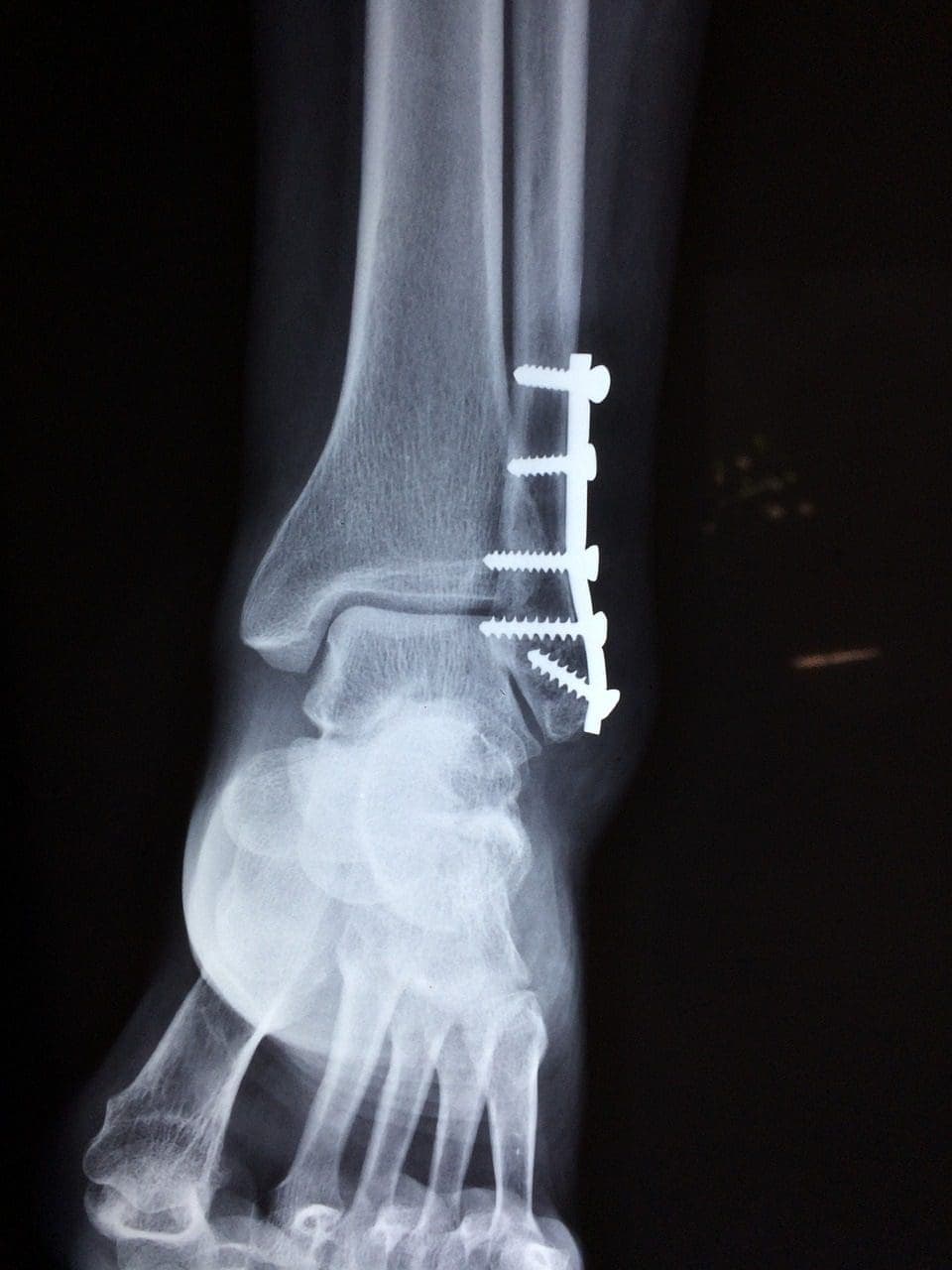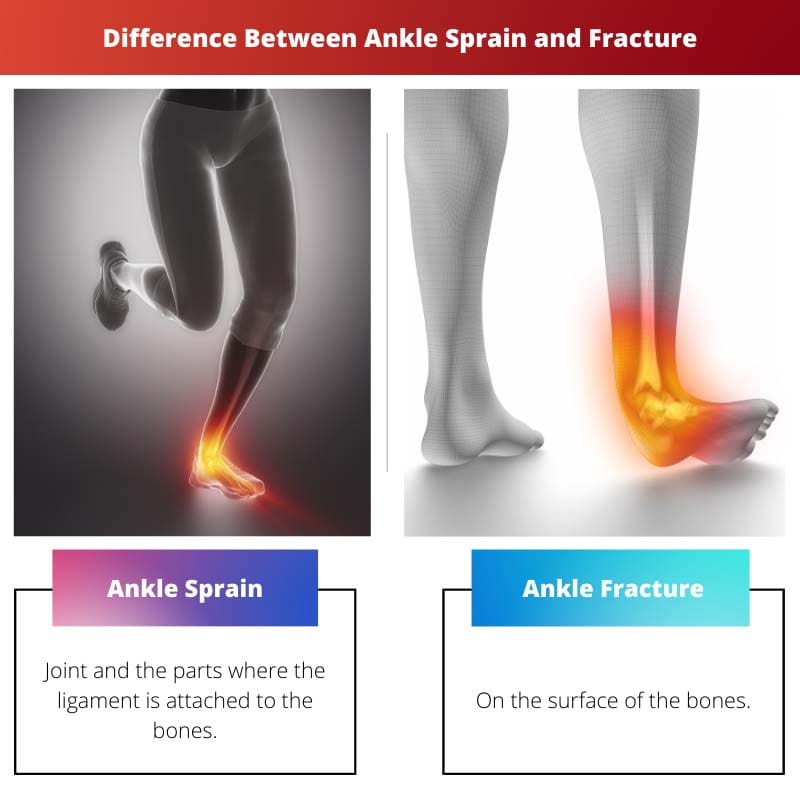Our ankles play a very essential role in our locomotion, the structure itself is sturdy enough to balance our body weight.
But sometimes, when we try to impress our high-school crush with a flying bicycle kick on the soccer field or try to beat the number one athlete with all we got, our carelessness pushes our ankles to the edge and we end up injuring ourselves.
To prevent our injury from causing much more pain and disastrous aftermath, we must be able to understand if we sprained our ankle or did one of our 3 ankle bones snapped!
Key Takeaways
- An ankle sprain is a stretching or tearing of ligaments in the ankle, while an ankle fracture is a break in one or more bones in the ankle.
- Ankle sprains are more common than ankle fractures and are less severe.
- Ankle fractures are more painful and require a longer recovery than ankle sprains.
Ankle Sprain vs Fracture
Sprain is a result of damage to the ligament, and fracture is the result of damage to the bone. In an ankle sprain, there is mild to moderate pain, while in a fracture, there is moderate to severe pain. Sprain is a result of damage to the ligament, and fracture is the result of damage to the bone.

An ankle sprain is something we all have experienced at least once in our lives.
The part where our foot meets our shin bone is called the ankle, and usually, we injure it if we miss-step on the stairs or run carelessly. A sprain is caused when a ligament is either injured or broken.
A ligament injury can be spotted if the part starts to swell and intolerable pain is felt.
But, if numbness and severe pain along with a blood clot is observed, clearly you have broken a bone or two.
So, if a numbness and shrill tickling is felt on that painful swollen ankle of yours, get ready for getting a plaster treatment because it’s an ankle fracture.
A fracture occurs when the injury directly impacts the bone and causes the breakage either on the surface of the bone or a deep crack on the part of the bone.
A fracture is a much more serious injury than a sprain, and an immediate treatment is always required.
Comparison Table
| Parameters of comparison | Ankle Sprain | Ankle Fracture |
|---|---|---|
| Cause | It is caused when a ligament present in the ankle joint gets injured or torn. A ruptured ligament can cause temporary movement disability too. | It is caused when one of the 3 ankle bones i.e: Tibia, Fibula or Talus is either broken or cracked on the surface. |
| Area of injury | Joint and the parts where the ligament is attached to the bones. | On the surface of the bones. |
| Sound | Usually occurs silently but sometimes a ‘popping’ sound is heard at the time of injury. | A ‘cracking’ sound is heard at the time of injury followed by numbness and severe pain. |
| Types | Ligament breakage, ligament rupture or stressed ligament. | Traverse, oblique, spiral, hairline, comminuted and displaced fractures. |
| Symptoms | The pain and swelling occurs in the joint, and blood clotting is not extreme. The area affected feels soft and stepping feels difficult. | Numbness and severe shrill pain is experienced. The swelling can sometimes be bluish because of excess blood clotting and even feather touches hurts on the bones. |
What is Ankle Sprain?
An ankle sprain is a type of injury that occurs when we carelessly misstep. It occurs with a ‘pop’ sound, and instantly we become unable to proceed with our stepping action.
The ankle joint is very strong and robust but sometimes the ligaments are stretched beyond their usual capacity, and we experience a sharp pain followed by some swelling, aka a sprain in the ankle joint.
Ligaments are elastic connective tissues present in our joints to smoothen the movements and mobility provided by joints.
They connect bone to bone, and hence, a sprain never affects a bone but the part of the bone that is connected to a neighbouring ligament.
A sprain can either cause the breakage of these fibrous tissues or the excessive stress on them causes immense pain.
Doctors suggest RICE (Rest, ice, compression, and elevation)along with diclofenac painkillers for sprains as well as hair-line fractures.
A moderate sprain lasts not more than two weeks, and the injury gets well without causing any major after-effects.

What is Ankle Fracture?
Just like a sprain, an ankle fracture is an injury that affects our ankle most painfully.
An ankle fracture occurs when we accidentally hit or stress our ankle bones to such an extent that the bone starts cracking or gets snapped.
A fracture is sometimes so serious that one can lose the ability to walk. Malleolus is the commonest part of the ankle that ends up being fractured.
Treating a fracture immediately can reduce the risk of complete bone displacement. Intense pain on the surface of the bone, as well as severe swelling, is observed on the injured part.
Blood clotting and numbness also occur in a fracture, and to reduce the primary effects of an ankle fracture, it is prescribed to use ice packs and reduce the swelling.
An immediate x-ray is a must to monitor the damage and type of fracture that has happened to your ankle. Hair-line ankle fractures are treated with a month-long plastering and rest.
However, an oblique displaced fracture and green-stick fractures in the ankle are treated with Intramedullary (IM) rods. These aids help in the stabilization of the fracture and faster bone recovery.

Main Differences Between Ankle Sprain and Fracture
- An ankle sprain is caused when the ligaments of the ankle are injured or torn, whereas an ankle fracture occurs when the ankle bones are broken or cracked.
- An ankle sprain is common and non-lethal, but an ankle fracture requires immediate medical attention.
- The sprain causes ‘pop’ sound, whereas fracture causes a ‘cracking’ sound
- An ankle sprain can cause severe pain, but a fracture causes numbness and extreme swelling in the ankle region.
- An ankle sprain occurs in the joint, but a fracture takes place precisely on the bones.

- https://orthoinfo.aaos.org/en/diseases–conditions/fractures-broken-bones/
- https://www.webmd.com/pain-management/picture-of-the-ankle

The article offers a comprehensive understanding of ankle sprains and fractures. It’s a useful resource for anyone interested in learning about these injuries.
Well said. The detailed information in the article provides clarity on ankle injuries and their management.
I found the explanation of the causes and symptoms of ankle sprains and fractures very thorough. It enhances my understanding of these types of injuries.
The description of RICE and the recovery period for ankle sprains is quite informative. It’s a well-rounded guide for managing such injuries.
Absolutely. The article provides valuable insights for self-care and recovery from ankle sprains.
Understanding the symptoms and types of fractures and sprains is crucial. It’s very informative to learn about the differences between them especially in the case of an ankle injury.
Absolutely. It serves as a good guide on when to seek medical attention and how to manage minor injuries at home.
The comparison table is a great summary of the differences between ankle sprains and fractures. It’s a useful resource for anyone interested in understanding these injuries.
I completely agree. It’s a commendable way to present the information for quick reference.
This article provides valuable insights into identifying the differences between a sprained and fractured ankle. The comparison table is particularly useful as a quick reference guide.
The clarity in explaining the symptoms and causes of ankle injuries is commendable. It’s a well-crafted article that provides comprehensive information.
Absolutely. The article is informative and offers a holistic view of ankle sprains and fractures.
The key takeaways are really helpful to distinguish between a sprain and a fracture. This could be useful to prevent misinformation and self-treatment. Great article!
I agree. RICE is a classic first response to sprains and minor fractures. It’s important to remember that severe fractures should always be attended by a professional.
The way the article highlights the symptoms and types of ankle sprains and fractures is impressive. It enables a clear understanding of these injuries.
Agreed. The information is presented in a comprehensive manner, making it highly informative.
The article effectively educates on the symptoms and causes of ankle sprains and fractures. It’s valuable knowledge for everyone.
The detailed description of symptoms and causes of sprains and fractures is very enlightening. A good read for anyone interested in anatomy and injuries.
Definitely. The article provides useful knowledge that can help differentiate between these injuries.
It’s refreshing to see such a well-explained medical article. It’s appreciated!